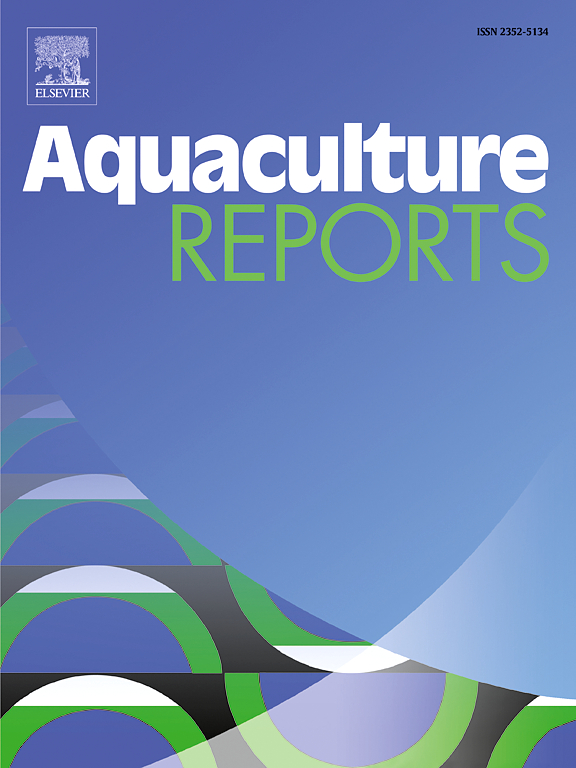Responses of largemouth bass (Micropterus salmoides) to chronic alkalinity stress: Survival, growth performance, physiology, and muscle quality
IF 3.2
2区 农林科学
Q1 FISHERIES
引用次数: 0
Abstract
Saline-alkaline water fishery has emerged as a highly promising aquaculture mode in China. To identify potential species suitable for saline-alkaline water aquaculture, this study investigated the effects of different alkalinity stresses (0, 7, 14, 21, 28 mmol/L) on the survival, growth performance, physiology, and muscle quality of largemouth bass Micropterus salmoides. A total of 450 fish (5.58 ± 0.09 g) were randomly allocated to 15 tanks, with three replicates for each group. The experiment lasted for two months. The results indicated that alkalinity stress exhibited no significant impact on the survival rate but significantly reduced growth performance. Compared with the control group, the ALK-28 group exhibited a significantly higher feed conversion ratio and a relatively lower protein efficiency ratio. Physiologically, as alkalinity increased, the concentrations of Na+ and Mg2+, along with the Na+/K+-ATPase and Ca2+/Mg2+-ATPase activities, showed an upward trend. Histologically, alkalinity stress induced some injuries to gills, including gill lamella hyperplasia, abnormal blood cells accumulation, and chloride cells rupture. For muscle nutrition and quality, no significant differences in the nutritional composition and water-holding capacity among treatments were observed. However, ALK-14 significantly enhanced the flavor and nutritional values of amino acids and fatty acids, and ALK-28 significantly improved textural characteristics, including higher hardness, chewiness, and resilience. These results suggested that largemouth bass is a potentially economic candidate species for saline-alkaline water aquaculture because it can survive and show advantages in muscle nutrition and quality under high alkalinity conditions.
大口黑鲈(Micropterus salmoides)对慢性碱性胁迫的反应:生存、生长性能、生理和肌肉质量
盐碱水域渔业已成为中国极具潜力的水产养殖模式。为了确定适合盐碱地水产养殖的潜在品种,本研究考察了不同碱度胁迫(0、7、14、21、28 mmol/L)对大口鲈(Micropterus salmoides)存活、生长性能、生理和肌肉质量的影响。共 450 尾鱼(5.58 ± 0.09 克)被随机分配到 15 个鱼缸中,每组三个重复。实验持续了两个月。结果表明,碱度胁迫对存活率无明显影响,但会显著降低生长性能。与对照组相比,ALK-28 组的饲料转化率明显较高,蛋白质效率比则相对较低。从生理学角度来看,随着碱度的增加,Na+和Mg2+的浓度以及Na+/K+-ATP酶和Ca2+/Mg2+-ATP酶的活性呈上升趋势。从组织学角度来看,碱度胁迫会对鳃造成一些损伤,包括鳃片增生、异常血细胞堆积和氯化物细胞破裂。在肌肉营养和质量方面,各处理的营养成分和持水能力无显著差异。然而,ALK-14 能明显提高风味和氨基酸与脂肪酸的营养价值,ALK-28 能明显改善质地特征,包括更高的硬度、咀嚼性和回弹性。这些结果表明,大口鲈是盐碱水养殖的潜在经济候选物种,因为它能在高碱度条件下生存,并在肌肉营养和质量方面表现出优势。
本文章由计算机程序翻译,如有差异,请以英文原文为准。
求助全文
约1分钟内获得全文
求助全文
来源期刊

Aquaculture Reports
Agricultural and Biological Sciences-Animal Science and Zoology
CiteScore
5.90
自引率
8.10%
发文量
469
审稿时长
77 days
期刊介绍:
Aquaculture Reports will publish original research papers and reviews documenting outstanding science with a regional context and focus, answering the need for high quality information on novel species, systems and regions in emerging areas of aquaculture research and development, such as integrated multi-trophic aquaculture, urban aquaculture, ornamental, unfed aquaculture, offshore aquaculture and others. Papers having industry research as priority and encompassing product development research or current industry practice are encouraged.
 求助内容:
求助内容: 应助结果提醒方式:
应助结果提醒方式:


